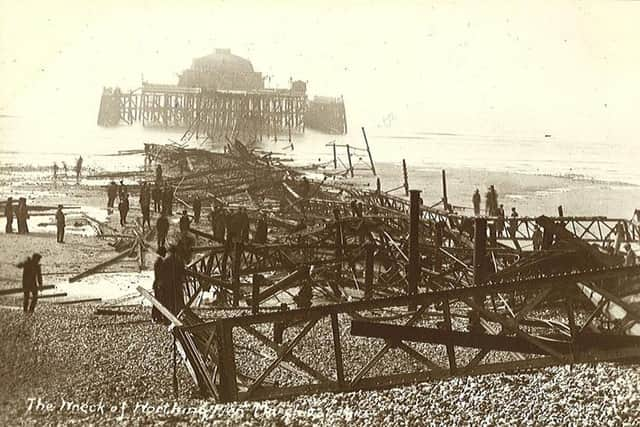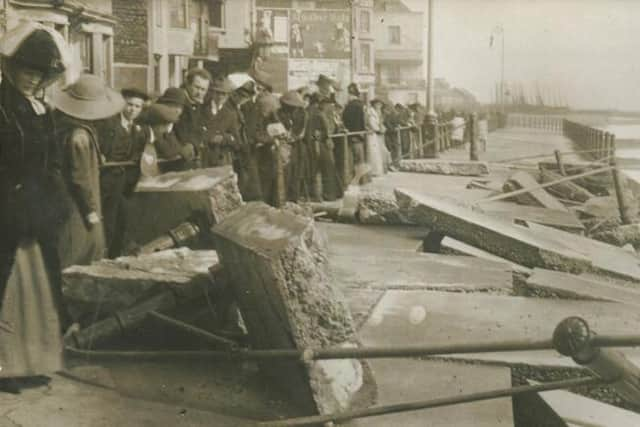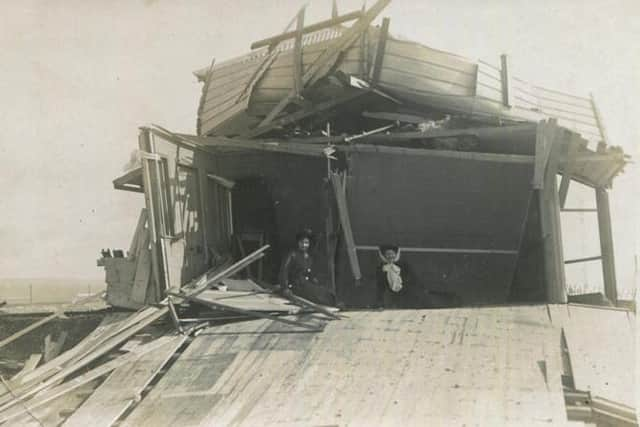Great storm that destroyed Worthing Pier and caused havoc all along the Sussex coast
and live on Freeview channel 276
I noticed many different images of storm damage during March 1913. From Worthing to Hastings, and all coastal towns in between and beyond, there was devastation caused by the storm which hit the south coast on the Easter weekend, Saturday, March 22, 1913. The events of that stormy night were reported all across Britain, and can be accessed through British Newspaper Archives online.
Reporting in the Sunderland Daily Echo on Monday, March 24, it stated: "Worthing was the town to suffer most. Huge seas repeatedly broke over the parade, flooding the adjacent streets. Shortly after midnight about 200 yards of the pier were swept bodily away, completely isolating the pavilion and the landing stages at the far end.
Advertisement
Hide AdAdvertisement
Hide Ad"The scene of the front yesterday morning was one of indescribable confusion. Huge piles of shingle and wreckage made the parade east of the pier well nigh impassable to pedestrians, whilst a number of iron seats from the pier were found on the beach more than a mile distant."


Bungalow Town, as Shoreham Beach was known in the early 1900s, was like an early version of Hollywood, with stars of the entertainment world choosing to live on this bohemian shingle bank. The elaborate wooden beach front bungalows which had sprung up from Shoreham to Lancing were extremely vulnerable to heavy storms.
Te Lichfield Mercury reported on Friday, March 28: "Bungalow Town for a distance of more than a mile between Lancing and Shoreham was devastated. Fifteen structures at least disappeared, and about the same number are irretrievably damaged. Thanks to warnings on Saturday evening the danger to life was reduced, but seven persons, mostly visitors, were temporarily isolated in a bungalow where they had a terrifying experience until the receding tide permitted of their release in the early hours of the morning. A man named Doick was blown into the Widewaters (a stretch of shallow water between the beach and the main road) during the height of the gale, and was rescued in the nick of time. Artificial respiration had to be resorted to before consciousness was restored."
Describing the resulting damage, the Lichfield Mercury goes on: "The damaged bungalows are twisted out of shape, and several appear on the point of collapsing. The shingle bank was strewn with heaps of bedding, furniture, and other household goods that had been hurriedly removed from the threatened residences. The sea defences also suffered extensive damage.
Advertisement
Hide AdAdvertisement
Hide Ad"At one point the shingle bank on which the bungalows stood has been moved inland a distance of nearly a hundred yards, completely altering the contour of the coast, and only the main Brighton to Worthing road, which rests on a bank of clay, now stands between the sea and 400 or 500 acres of low-lying land on either side of the railway. The main road between Lancing and Worthing was impassable owing to accumulations of shingle and wreckage."


The Sunderland Daily Echo and Shipping Gazette, wrote of Hove and Brighton, under the headline 'Sea’s inroads at Hove': "The eastern end of the Hove Esplanade was partly washed away. The asphalte slope which marks off the long parade at West Hove from the beach disappeared, and the sea carried the shingle over the asphalte and left it there to a depth of several inches. Yesterday large gangs of men were busy clearing a path two feet wide.
"Brighton was saved to some extent by an abundance of beach accumulated by stone groynes, but a considerable amount of damage was done. The swimming stage at the head of the Palace Pier, on the east side, was practically destroyed, while the doors of several arches on the Lower Esplanade were forced in. Volk’s Electric Railway was torn up in parts. Portions of the wreckage from Worthing Pier were washed up on the shore at the point whence the old chain pier projected."
While the Lichfield Mercury states: "Brighton also can scarcely remember a gale so fierce. On Saturday afternoon it began with a sudden whirlwind, followed by torrential rains. As the night came on the wind increased, and for several hours blew with hurricane force. Houses seemed to be shaken to their foundations, and there was general alarm. Much damage was done to the front, which on Sunday morning presented an extraordinary appearance.
Advertisement
Hide AdAdvertisement
Hide Ad"The sea in places made great in-roads, and at the most easterly end the road-way was torn up. At this point so completely was the road covered with stones thrown up by the waves that it was closed to vehicular traffic. On the trim bowling greens at King’s Cliff fishing and other boats found a safe anchorage. Several boats were smashed to pieces. Some arches on the under parade were considerably battered, and the 'sea-going electric railway' was in parts demolished."


Of the Hastings storm damage, the Exeter and Plymouth Gazette writes: "On Saturday midnight the tide at Hastings was the highest for years. It was accompanied by heavy wind, and considerable damage was done along the seafront. The rough seas dashed past the Memorial Clock Tower some distance from the front, and numbers of basements were flooded."